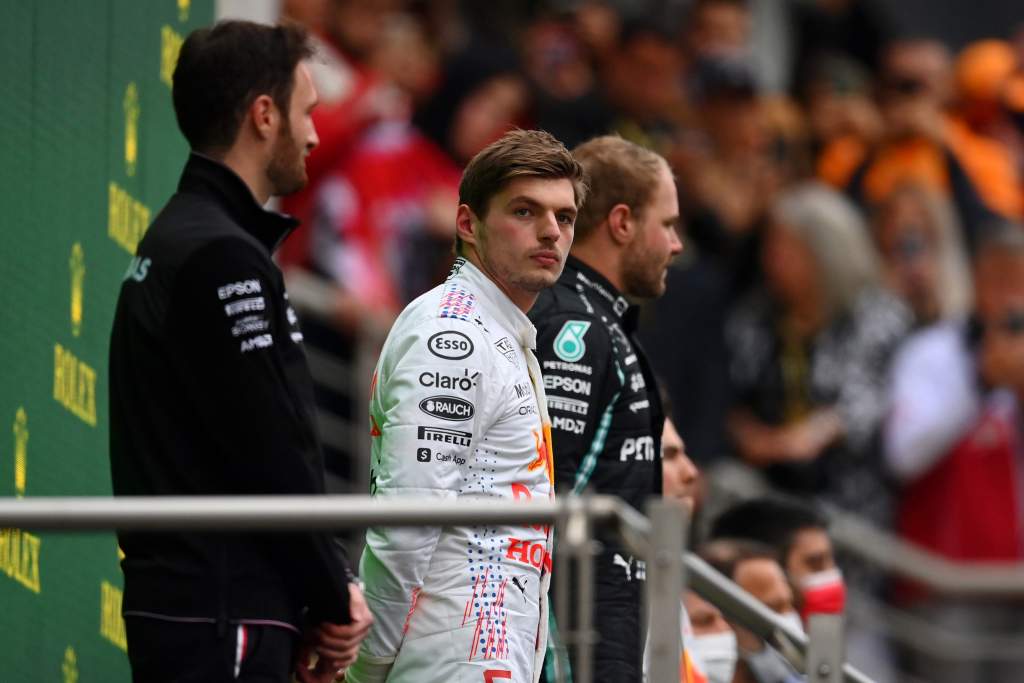Up Next

Mercedes’ speed around Istanbul sent a strong warning to Red Bull-Honda and Max Verstappen. How real is that advantage and if it’s real, where has it come from?
As Verstappen said after the race: “We have been at tracks that naturally were a bit better for Mercedes but then this track was a bit unknown and clearly they were ahead of us. I do think we need to step it up a bit to be in the fight until the end of the season.”
There is nothing about the layout of Istanbul Park which should have favoured the concept of one car over the other. The pattern, in general, has been circuits that give more laptime reward for pure downforce have favoured Red Bull’s high-rake concept. Those placing extra importance on low drag have favoured the Mercedes. That’s what Verstappen was referencing.
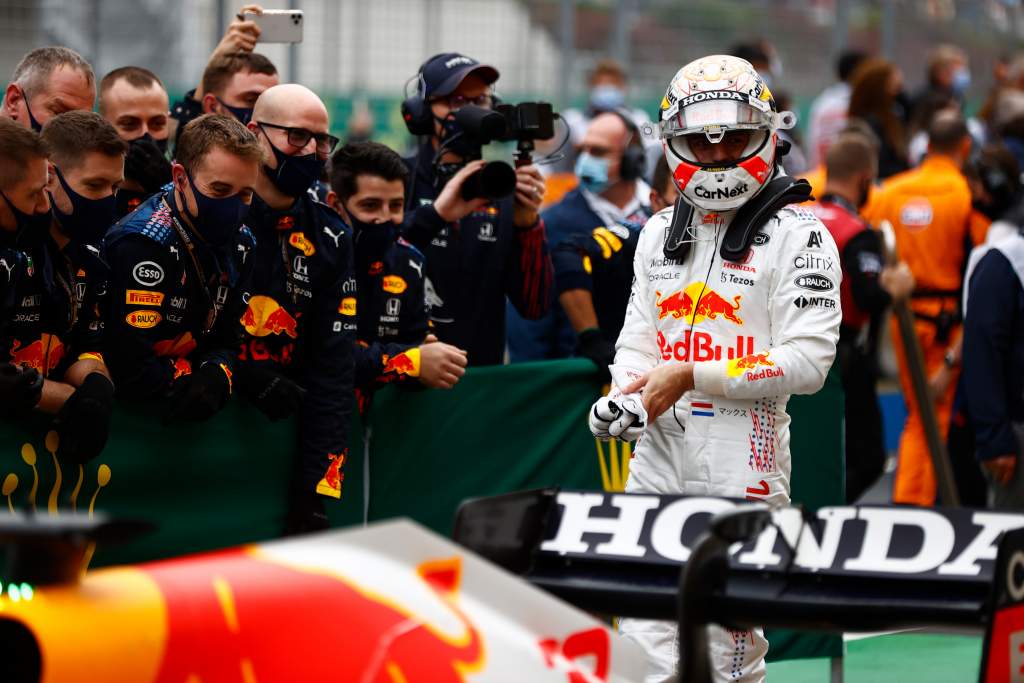
Since Verstappen’s comfortable victory in Zandvoort (a downforce track), we’ve been to Monza (which always looked likely to be Mercedes all the way) and Sochi (another Mercedes stronghold).
Istanbul Park gives a good balance of demands between the two. The straights are not particularly long but – rather like at Silverstone – any turns which are flat-out, such as Istanbul’s long Turn 8, will favour the low-drag car. The combination of the flat-out Turn 8 and Turn 11 with the more fiddly sections should in theory have made the two concepts of car quite evenly matched over the lap. But Verstappen trailed a vital couple of tenths to Valtteri Bottas’ Merc in qualifying and was always controlled by him in the race.
Perhaps the track sequencing since Mercedes’ very productive upgrade at Silverstone has disguised the extent of the competitive shift between the two cars.
Since Silverstone, F1 has visited Hungary (where the Red Bull was in all sorts of bother and Merc’s advantage was therefore unrepresentative), Spa (where we didn’t get to see the full picture play out because of the non-race), Zandvoort (a downforce track where Red Bull was expected to be faster and was), Monza (ditto Mercedes) and Sochi (nominally Mercedes but Verstappen didn’t try to set a qualifying time and had a compromise skinny wing on for his starting position on the back row, which played a part in his tyre graining issues).
So before Istanbul, the track sequencing meant there were sound reasons to believe what we were looking at was just a continuation of an evenly-matched performance between the two cars, varying from one layout to another. The only misnomer there was Hungary but there was a specific Red Bull problem there. But the Istanbul picture perhaps demands we look at that sequence of races in a different light. Was Mercedes’ Silverstone upgrade so good that it has put it in front ever since, and kept it there (with the exception of Zandvoort)? Or have gains been made on the power unit?
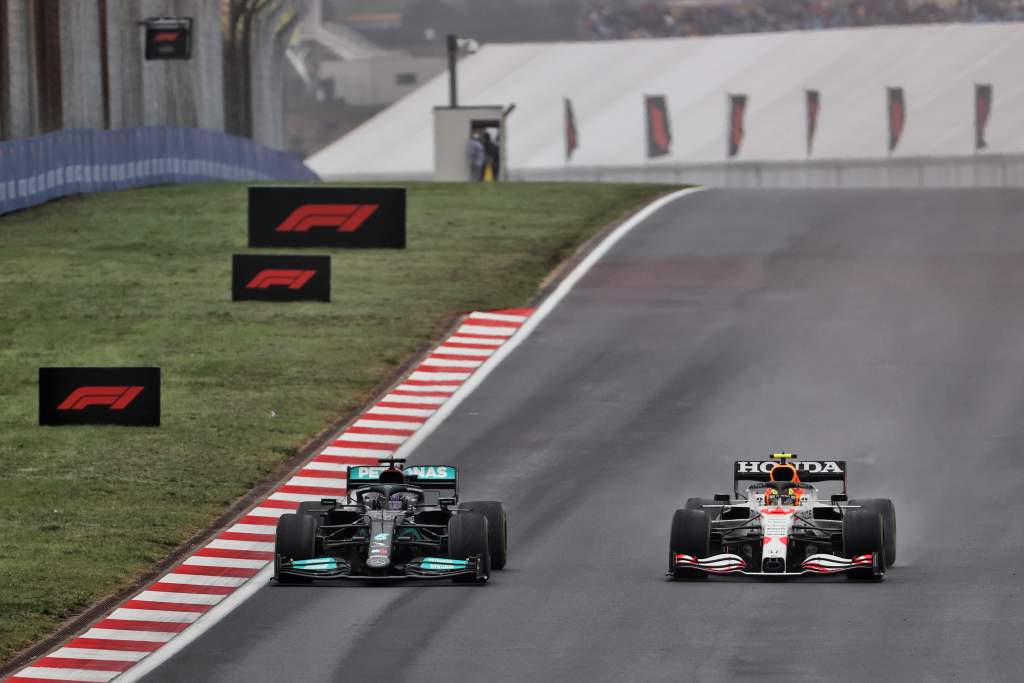
Red Bull is adamant that Mercedes has found more power since Red Bull’s France-Austria spell of being able to match them on the straights. “Their straight-line speed has taken a significant step recently,” said Christian Horner in Turkey, “and I think that while we could match them with smaller wings previously, now we can’t get near.”
Mercedes is equally adamant it has not made significant power gains. The straight-line speed differences are, it suggests, indicative either of something having changed with the Honda PU (which Honda very much denies) or just a different playing out of wing choices from circuit to circuit.
One way of getting a better read on this would be to compare Merc’s advantage over more than just Red Bull, to see how much of the apparent swing in Merc’s favour is down to Red Bull difficulties not getting its car in the balance sweet spot at Hungary (and to an extent Turkey) and how much to genuine Mercedes progress. (see accompanying graphs and data)
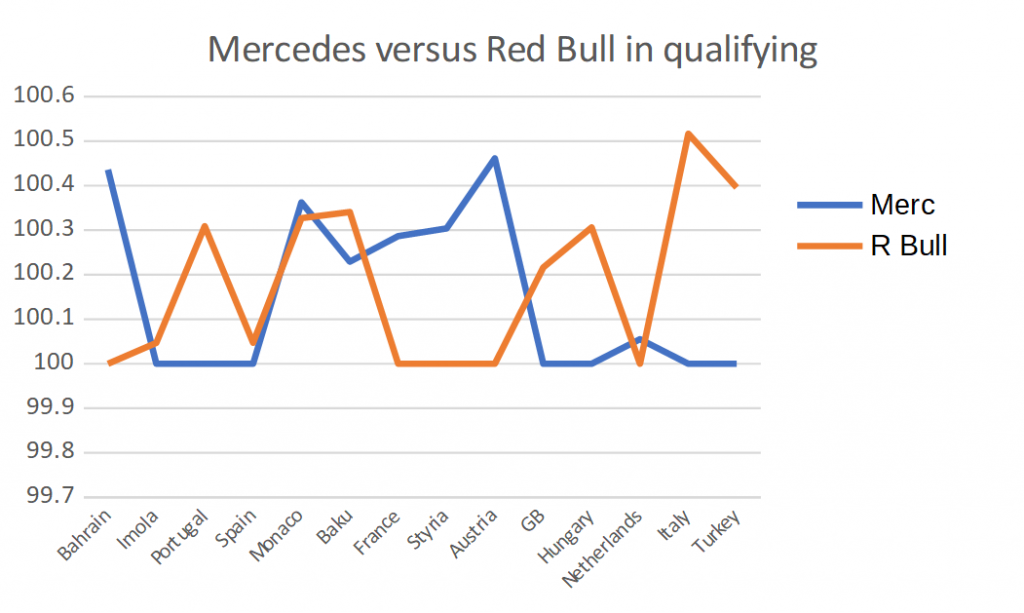
Red Bull
Pre-Britain Red Bull 0.1121% faster than Mercedes
Post-Britain Red Bull 0.276% slower than Mercedes
0.3881% swing in Merc’s favour
McLaren
Pre-Britain McLaren 0.4062% slower than Mercedes
Post-Britain McLaren 1.0901% slower than Mercedes
0.6839% swing in Merc’s favour
Ferrari
Pre-Britain Ferrari 0.4896% slower than Mercedes
Post-Britain Ferrari 0.9459% slower than Mercedes
0.4563% swing in Merc’s favour
AlphaTauri
Pre-Britain AlphaTauri 0.6312% slower than Mercedes
Post-Britain AlphaTauri 0.9881% slower than Mercedes
0.3669% swing in Merc’s favour
Alpine
Pre-Britain Alpine 0.9525% slower than Mercedes
Post-Britain Alpine 1.3985% slower than Mercedes
0.446% swing in Merc’s favour
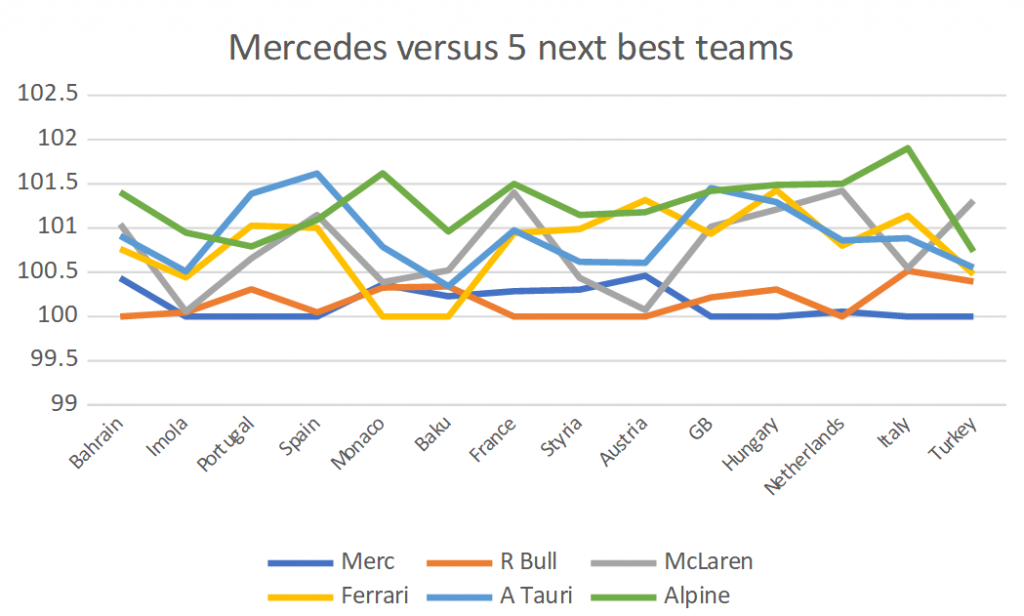
That looks pretty decisive. The Merc’s advantage after its Silverstone upgrade was apparent over the field, not just over Red Bull. Red Bull’s advantage over the rest of the field has stayed much the same as an average.
We should be careful with just measuring qualifying times as there were a few instances earlier in the season where Mercedes was flattered in qualifying either by wing choice (Baku, where the skinny wing gets you the qualifying time but destroys your tyres in the race) or errors from the Red Bull drivers when the RB16B was the faster car (Imola).
There were also races where the qualifying difference between them was very small, but the race pace advantage at the crucial times was much bigger (Spain in Merc’s favour, France in Red Bull’s). Then there was Silverstone where the Red Bull was consistently faster in hot temperatures but Friday qualifying took place at the only time of the weekend when the track was relatively cool. But accepting all of those caveats, we can still say with a fair degree of certainty that Mercedes has established an advantage since pre-Silverstone. It is real, and not just skewed by Red Bull’s particular problems.
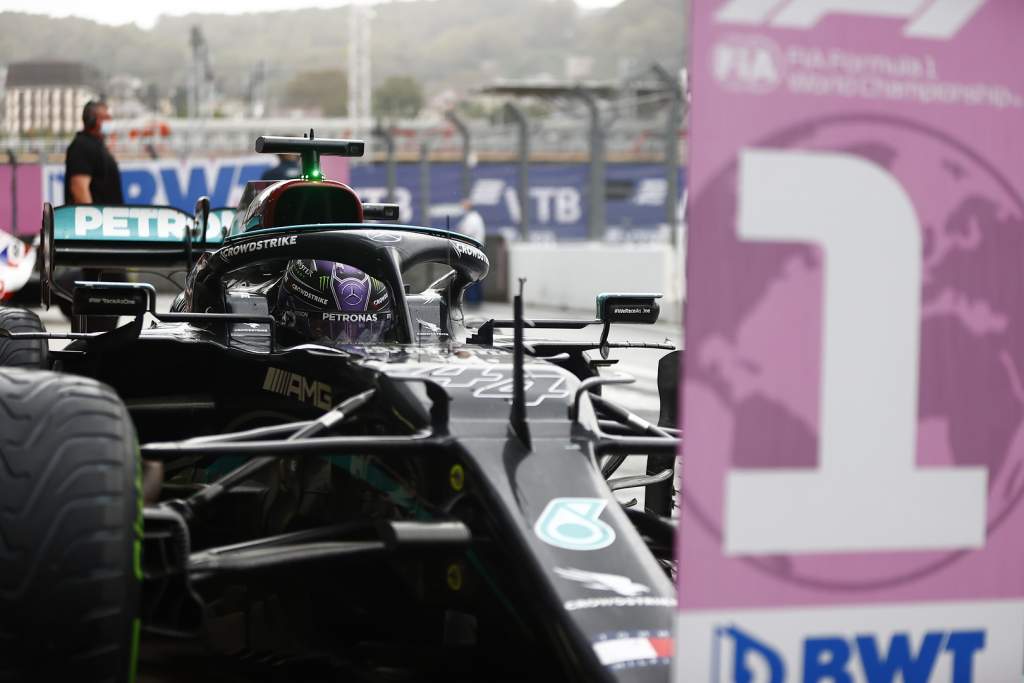
This just leaves the question of track sequencing. Has the sequence of tracks just happened to skew the picture towards the low-rake concept while the actual performance of the two cars remained as they were before relative to each other?
One way of testing that thesis would be to compare the relative performance of the only other low-rake concept car, the Aston Martin. That shows the very same pattern against the Merc – ie the Aston’s deficit to Mercedes grew post-Silverstone, in this case by 0.552%.
So even track sequencing cannot fully account for the Mercedes improvement. That Silverstone aero upgrade – a totally reworked barge board area around the front corner of the floor, a reprofiled floor edge and re-angled deflectors, and modifications to the ‘cake tins’ within the wheels – seems to have been a very effective one. There may or may not have been gains made in the power unit’s usage.
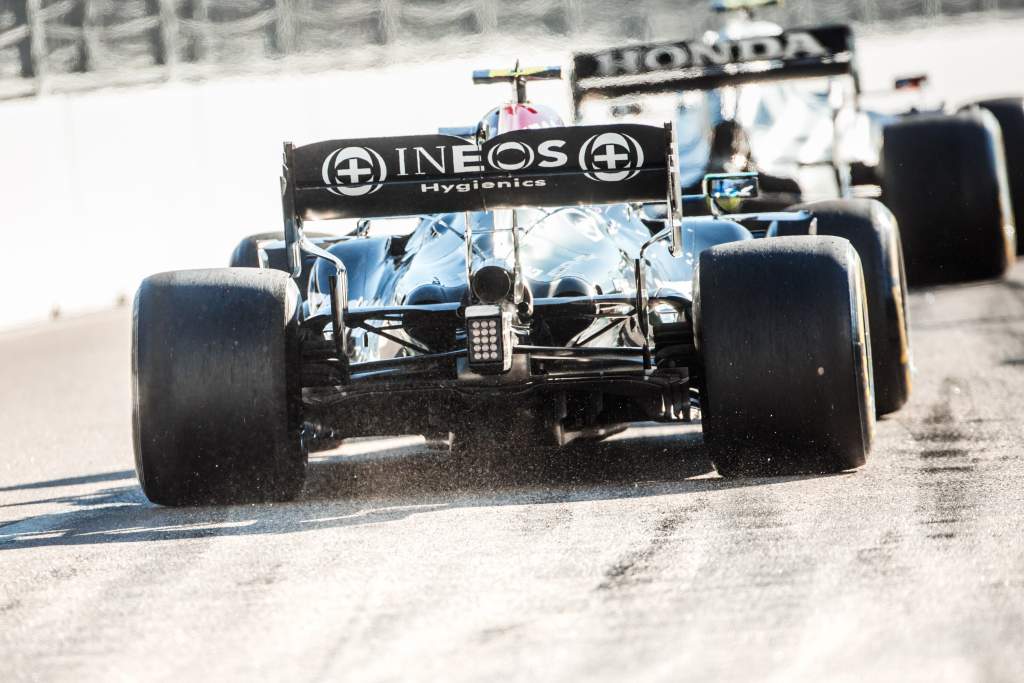
The remaining theory is that of the stiffer rear Pirellis introduced at Silverstone having helped the Merc’s diffuser performance. The timing fits but nothing else does. Mercedes did not have a diffuser problem before Silverstone, just a general lower downforce ceiling than the Red Bull. The aero guys were quite happy with the way the car was operating relative to simulation; it was just that still gave a general downforce deficit. It wasn’t as if the car had a problem with inconsistent downforce, which would be the trait apparent if the tyre flex was interfering with the diffuser performance.
What the Merc Silverstone upgrade appeared to be about was altering the emphasis between underfloor airflow and that going around the sidepods. In that way, it was seeking to energise the floor more, as on a low-rake car it’s naturally limited in the negative pressure it can create compared to a high-rake concept.
If Mercedes succeeded in doing that it will have allowed the optimum wing level for any circuit to be lower. Downforce created by the underbody is far less draggy than that created by the wings. That would go some way to explaining Horner’s observation about the difference in straight-line speeds between earlier in the season and now.
In conclusion, Verstappen is right to be concerned.


